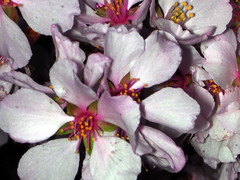
Image by shankargallery via Flickr
Meditation has many important benefits, and meditation and pranayama can help us live longer, happier and more productive lives. It is important to understand just what these terms mean, but first a few of the important benefits of pranayama and meditation.
- Meditation and pranayama can help improve breathing and reduce respiratory ailments.
- Meditation and pranayama can help to lower blood pressure
- Meditation and pranayama can help the organs of the body, like the lungs and the heart, work more efficiently
- Meditation and pranayama can help us gain control over the mind, improve memory and concentration.
- Meditation and pranayama can calm our thoughts, relieve tension and reduce feelings of frustration.
What is Pranayama?
It would be wrong to call pranayama a technique, since the word technique tends to lessen the importance of this important practice. Pranayama is derived from two words – prana and ayama. Prana means “breath” and ayama means “dimension”, thus pranayama is a conscious way to breathe in order to achieve the desired results. The breathing cycle of pranayama is divided into three steps:
- Puraka
- Kumbhaka (divided into anta-kumbhaka and bahya-kumbhaka)
- Rechaka
The first part is the puraka step. During this step the inhalation is slow enough for the practitioner to feel the air filling the lungs and nourishing the body. During normal breathing we do not typically experience this, since the breaths we take are shallow. During pranayama, however, we consciously attempt to fill our lungs completely and deeply, and we see our lungs expand to their maximum dimension. The inhalation is peaceful and complete.
Rechaka is the exhalation portion of the breathing exercise. The rechaka is equally slow and deliberate, and the practitioner will feel his or her lungs contracting.
Retention, or kumbhaka has two types – internal retention (antar-kumbhaka) and external retention (bahya-kumbhaka). The first one is very important, since it gives the alveoli plenty of time to exchange the oxygen the inhalation has brought into the lungs, and plenty of time for the lungs to take the carbon dioxide out of the lungs during the exhalation. It is important to retain the breath in the lungs in order to give them plenty of time to make this important exchange.
The normal volume of air exchanged during a normal breathing cycle is between 200ml and 300ml. However, with careful and conscious breathing during pranayama, it is possible to increase this volume of air up to as much as 500ml for a healthy adult practitioner.
During the typical pranayama session, the practitioner should chant the mantra “Om” for 10 to 12 seconds while performing the breathing exercises. The chant can be
The normal volume of air handled per cycle of breathing is measured and is around 200 – 300 ml. But with the watchful and conscious pranayama, it is found to increase up to 500 ml in healthy adults.
During the practice of pranayama, the mantra “Om” should be chanted for 10 to 12 seconds, while you inhale and exhale completely. This time can be extended depending on the comfort level of the practitioner.
In order to get a feel for the effectiveness of this technique, place your palm flat on your diaphragm as you start chanting and move to your mid chest and finally to the top of your lung.
